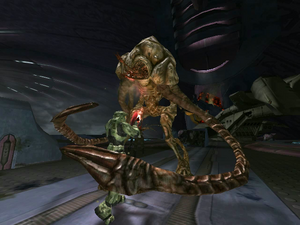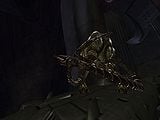Flood Juggernaut
From Halopedia, the Halo wiki
"WE'VE GOT A NEW CONTACT, UNKNOWN CLASSIFICATION!" This article may contain information based upon upcoming, unreleased, or recently-released content from Halo Wars 2: Awakening the Nightmare, and may not be fully complete. Additionally, the information may be subject to change if it is based on pre-release material. Please update it as soon as any relevant and accurate material is available.
|
The Flood Juggernaut is a large Flood form found in the game files of Halo 2. The Abomination Flood form is an evolution of the Juggernaut.[1]
Background
Juggernauts were originally slated to appear in the levels "The Oracle" and "Quarantine Zone". There would never be more than one Juggernaut in any given place. Once the player eliminated it, the combat forms that were supplementing it would go "offline". The Juggernaut has four to six infection forms inside its body to control it, similar to combat forms. According to Robert McLees, the Juggernaut was supposed to be "... this uber-intelligent mini boss, but the suggested intelligence was way too high for what design needed to use it for, which was as a big tank".[2]
The Juggernaut was also the conceptual progenitor of the pure forms seen in Halo 3. However, whereas the Juggernaut was to be controlled by infection forms, pure forms are created entirely from Flood biomass.[2]
The design of the Abomination Flood form introduced in Halo Wars 2 is seemingly based on the Juggernaut.
Gameplay
The Juggernaut's model and AI are still present in the the game files, allowing the NPC to be added to gameplay via modding, similar to the Huragok in Halo: Combat Evolved. The Juggernaut stands nearly twice as tall as a Spartan or an Elite. It has two large tentacles that can kill the player character with only one hit. They also can jump much higher and farther than regular combat forms can. They often jump high in the air at the player character when noticed, sometimes landing on top of them and killing them instantly. The Juggernaut will also sometimes forget the player character is there remain still for a few moments. Finding cover is ill-advised, as the Juggernaut will knock hit it out of the way, sending the object a great distance and killing the player if it connects. The Juggernaut is highly resistant to damage. Powerful weapons such as the shotgun and rocket launcher are all but necessary against it.[citation needed]
Through modding, it has been found that the Juggernauts have a defensive position; stopping and moving their whip-like appendages in front of their body in an X formation. When running low on health, some occurrences have happened where the Juggernaut goes berserk, waving its tentacles around wildly before striking the player with speed. As Bungie never programmed a death animation for the Juggernaut, when it dies, it simply freezes in place.[citation needed]
Although the model, textures, etc. for the Juggernaut are stored in the files of the level "High Charity", there are no spawn points for it. Modders and Halo 2 Vista players can fight against the Juggernaut on the level by switching them to spawn in place of another character's existing spawn point.[citation needed]
Trivia
- The Art of Halo features a concept sketch of the Flood carrier form that resembles the Juggernaut.
- Juggernauts are playable pieces in Halo Wars Risk. However, they do not resemble the Juggernaut, rather looking like a Thrasher Form instead.
- In the motion comic adaptation of the short story "The Mona Lisa", a Sangheili-derived combat form closely resembles the Juggernaut.
Gallery
A Juggernaut-like form in The Mona Lisa. Note that it spawned from a Sangheili host, indicated by its head being on the right shoulder.
Sources
- ^ Halo Wars 2, Phoenix Log: Abomination
- ^ a b c Bungie.net: Feast of Bones




